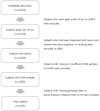Association of circulating 25-hydroxyvitamin D levels with hypertension and blood pressure values in Korean adults: A Mendelian randomization study on a subset of the Korea National Health and Nutrition Survey 2011-2012 population
- PMID: 31814925
- PMCID: PMC6883232
- DOI: 10.4162/nrp.2019.13.6.498
Association of circulating 25-hydroxyvitamin D levels with hypertension and blood pressure values in Korean adults: A Mendelian randomization study on a subset of the Korea National Health and Nutrition Survey 2011-2012 population
Abstract
Background/objectives: Lower circulating 25-hydroxyvitamin D [25(OH)D] levels are associated with a higher risk of hypertension (HTN); however, it remains unclear whether the relationship is causal. We aimed to evaluate the causal effects of circulating 25(OH)D levels on the prevalence of HTN in the Korean population using the Mendelian randomization (MR) approach.
Subjects/methods: Epidemiological data, serum 25(OH)D data, and genomic DNA biospecimens were obtained from 2,591 participants, a subset of the study population in the Korea National Health and Nutrition Survey 2011-2012. Five 25(OH)D-related single nucleotide polymorphisms (SNPs; DHCR7 rs12785878, CYP2R1 rs10741657, CYP2R1 rs12794714, CYP24A1 rs6013897, and GC rs2282679), identified a priori from genome-wide association studies, were used as instrument variables (IVs) for serum 25(OH)D levels. In the MR analysis, we performed IV analyses using the two-stage least squares method.
Results: In the observational analysis, circulating 25(OH)D levels were found to be inversely associated with the HTN prevalence in ordinary least squares models (odds ratio: 0.97, 95% confidence interval: 0.96, 0.99) after adjusting for the potential confounders. There were differences in the circulating 25(OH)D levels across genotypes of individual SNPs. In the MR analysis, using individual SNPs as IVs, 25(OH)D levels were not associated with the HTN prevalence.
Conclusions: We found no association between genetically determined circulating 25(OH)D levels and HTN in Korean adults. Our results are listed owing to the relatively small sample size and possible weak instrument bias; therefore, further studies are needed to confirm these results.
Keywords: Vitamin D; blood pressure; causality; hypertension.
©2019 The Korean Nutrition Society and the Korean Society of Community Nutrition.
Conflict of interest statement
CONFLICT OF INTEREST: The authors declare no potential conflicts of interests.
Figures
Similar articles
-
Association among genetic variants in the vitamin D pathway and circulating 25-hydroxyvitamin D levels in Korean adults: results from the Korea National Health and Nutrition Examination Survey 2011-2012.Endocr J. 2018 Sep 27;65(9):881-891. doi: 10.1507/endocrj.EJ18-0084. Epub 2018 Jun 22. Endocr J. 2018. PMID: 29937467
-
Association of serum 25-hydroxyvitamin D with metabolic syndrome and type 2 diabetes: a one sample Mendelian randomization study.BMC Geriatr. 2021 Jun 29;21(1):391. doi: 10.1186/s12877-021-02307-6. BMC Geriatr. 2021. PMID: 34187381 Free PMC article.
-
A Bidirectional Mendelian Randomization Study to evaluate the causal role of reduced blood vitamin D levels with type 2 diabetes risk in South Asians and Europeans.Nutr J. 2021 Jul 27;20(1):71. doi: 10.1186/s12937-021-00725-1. Nutr J. 2021. PMID: 34315477 Free PMC article.
-
Relative importance of summer sun exposure, vitamin D intake, and genes to vitamin D status in Dutch older adults: The B-PROOF study.J Steroid Biochem Mol Biol. 2016 Nov;164:168-176. doi: 10.1016/j.jsbmb.2015.08.008. Epub 2015 Aug 11. J Steroid Biochem Mol Biol. 2016. PMID: 26275945 Review.
-
Circulating levels of 25-hydroxyvitamin D in relation to hypertension in children and adolescents: a systematic review and dose-response meta-analysis of epidemiologic studies with GRADE assessment.J Transl Med. 2025 Jun 3;23(1):625. doi: 10.1186/s12967-025-06668-z. J Transl Med. 2025. PMID: 40462141 Free PMC article.
Cited by
-
Data Resource Profile: The Statistics of the Korea National Health and Nutrition Examination Survey (KNHANES) Biobank Project.J Korean Med Sci. 2025 Jun 16;40(23):e189. doi: 10.3346/jkms.2025.40.e189. J Korean Med Sci. 2025. PMID: 40524629 Free PMC article. Review.
-
The health effects of vitamin D supplementation: evidence from human studies.Nat Rev Endocrinol. 2022 Feb;18(2):96-110. doi: 10.1038/s41574-021-00593-z. Epub 2021 Nov 23. Nat Rev Endocrinol. 2022. PMID: 34815552 Free PMC article. Review.
-
Vitamin D and human health: evidence from Mendelian randomization studies.Eur J Epidemiol. 2024 May;39(5):467-490. doi: 10.1007/s10654-023-01075-4. Epub 2024 Jan 12. Eur J Epidemiol. 2024. PMID: 38214845 Review.
-
Serum Vitamin D Levels in Relation to Hypertension and Pre-hypertension in Adults: A Systematic Review and Dose-Response Meta-Analysis of Epidemiologic Studies.Front Nutr. 2022 Mar 10;9:829307. doi: 10.3389/fnut.2022.829307. eCollection 2022. Front Nutr. 2022. PMID: 35360696 Free PMC article.
-
Mendelian randomization analysis of vitamin D in the secondary prevention of hypertensive-diabetic subjects: role of facilitating blood pressure control.Genes Nutr. 2022 Jan 29;17(1):1. doi: 10.1186/s12263-022-00704-z. Genes Nutr. 2022. PMID: 35093020 Free PMC article.
References
-
- Kunutsor SK, Apekey TA, Steur M. Vitamin D and risk of future hypertension: meta-analysis of 283,537 participants. Eur J Epidemiol. 2013;28:205–221. - PubMed
-
- Golzarand M, Shab-Bidar S, Koochakpoor G, Speakman JR, Djafarian K. Effect of vitamin D3 supplementation on blood pressure in adults: an updated meta-analysis. Nutr Metab Cardiovasc Dis. 2016;26:663–673. - PubMed
-
- Vimaleswaran KS, Berry DJ, Lu C, Tikkanen E, Pilz S, Hiraki LT, Cooper JD, Dastani Z, Li R, Houston DK, Wood AR, Michaëlsson K, Vandenput L, Zgaga L, Yerges-Armstrong LM, McCarthy MI, Dupuis J, Kaakinen M, Kleber ME, Jameson K, Arden N, Raitakari O, Viikari J, Lohman KK, Ferrucci L, Melhus H, Ingelsson E, Byberg L, Lind L, Lorentzon M, Salomaa V, Campbell H, Dunlop M, Mitchell BD, Herzig KH, Pouta A, Hartikainen AL, Streeten EA, Theodoratou E, Jula A, Wareham NJ, Ohlsson C, Frayling TM, Kritchevsky SB, Spector TD, Richards JB, Lehtimäki T, Ouwehand WH, Kraft P, Cooper C, März W, Power C, Loos RJ, Wang TJ, Järvelin MR, Whittaker JC, Hingorani AD, Hyppönen E Genetic Investigation of Anthropometric Traits-GIANT Consortium. Causal relationship between obesity and vitamin D status: bi-directional Mendelian randomization analysis of multiple cohorts. PLoS Med. 2013;10:e1001383. - PMC - PubMed
-
- Scragg R, Holdaway I, Jackson R, Lim T. Plasma 25-hydroxyvitamin D3 and its relation to physical activity and other heart disease risk factors in the general population. Ann Epidemiol. 1992;2:697–703. - PubMed
LinkOut - more resources
Full Text Sources
Miscellaneous


